City guides


Sydney Travel Guide
Sydney is Australia's most popular tourist hotspot, luring millions of holidaymakers every year with the promise of sun, sand, merry-making and culture. It is slick and smart, the streets are clean, the parks sublime, the water in the huge harbour bright blue, and the landmark buildings breathtaking. Sydney's population is approaching five million, but it is easy to leave the frenetic urban pace behind with just a simple ferry ride to the North Shore for a bush walk, or a stroll along the harbour beaches, or any one of a number of daytrips to explore the 'real' Australia on the city's doorstep.
Just like its characteristic white-sailed Opera House, Sydney seems to cruise effortlessly through nights and days filled with myriad entertainment opportunities, sophisticated shopping, memorable museums, and strings of beautiful beaches. It can be exhausting to take it all in, even though the tourist precinct where most of the interesting attractions are to be found is concentrated in quite a small area around the downtown waterfront and harbour. The fact that Sydney is a thriving seaport and industrial city has been cleverly concealed behind attractive pleasure and leisure grounds and residential suburbs, making full use of the scenic, watery geographical location.
The harbour area is dominated by the span of one of the world's largest arched bridges, backed by towering skyscrapers. Another plus for visitors is that, compared to most big cities, Sydney offers excellent reasonably priced food, accommodation and public transport. The city also has an efficient suburban rail network, with its hub at Circular Quay in the city centre, while full use is made of the waterways with ferries and passenger jet boats plying to and from various points.
To the north of Sydney is the Pacific Coastal route, which passes beautiful coastal scenery, laid back seaside communities such as Byron Bay, and excellent surf, with nearly 249 miles (400km) of beaches to explore. Whale watching is popular in season and the region is also dotted with numerous national parks and nature reserves that offer plenty of hiking trails and kayaking in the Myall Lakes. The Waterfall Way, which winds up to the New England Tablelands, is one of the most scenic drives in the world, taking in the vineyards of the famed Hunter Valley. To the south of Sydney is Australia's only alpine habitat in the Snowy Mountains, where winter skiing is the main attraction. In summer, the mountains become a playground for whitewater rafters, fishermen, kayakers and hikers, making Sydney a great travel hub.
Best time to visit Sydney
The most popular time to travel to Sydney is during the summer months, between November and March, when it is hot and sunny. Winter in Sydney (June to August) is mild but damp, and nights can be chilly.
What to see in Sydney
-Explore Darling Harbour, Sydney's hottest tourist district.
-Interact with some of Australia's most loveable animals at Featherdale Wildlife Park.
-Catch a show or take a tour of the iconic Sydney Opera House.
-View the city from the staggering heights of the Sydney Tower.
What to do in Sydney
-Bask in the sun on one of the many glorious beaches in or near Sydney.
-Climb the famous Harbour Bridge for stunning views of the city.
-Stroll around Sydney's beautiful Royal Botanic Gardens.
-Enjoy the good restaurants and historic buildings of The Rocks.
Beyond Sydney
New South Wales is chock full of remarkable natural landscapes and those on holiday in Sydney have an array of excursion to choose from: The Blue Mountains and the Snowy Mountains are playgrounds for outdoor enthusiasts; the historic mining town of Broken Hill attracts many visitors; and the vineyards of the scenic Hunter Valley just beg to be explored on a roadtrip. New England boasts many beautiful landscapes, and Byron Bay, on the north coast, promises pristine beaches.
Getting there
Kingsford-Smith Airport, often just called Sydney Airport, is the starting point for many New South Wales holidays. The airport is situated just six miles (9km) south of the city.
Did you know?
-The Sydney Harbour Bridge is the widest and tallest steel arch bridge in the world.
-George Street is the oldest street in Australia.
-Sydney boasts the deepest natural harbour on Earth.
Things to do in Sydney
Sydney is one of the world's top holiday destinations, offering a variety of attractions for all ages. Families can explore the sights at Darling Harbour, including one of the biggest and most impressive aquariums in the world; observe some fascinating Australian fauna and flora at Wildlife Sydney Zoo; and watch a film on the huge screen at the Imax theatre.
Those interested in history will want to explore the cobbled streets of The Rocks, a restored 19th-century village that was the site of Australia's first European settlement in 1788. The Rocks also gives access to the Pylon Lookout on the famous Sydney Harbour Bridge for an amazing view of the harbour, Sydney Opera House and beyond. Adventurers will definitely want to experience the iconic bridge from a more thrilling perspective though, and can take part in an organised climb to the top of Harbour Bridge for breath-taking views and a sense of bold achievement. For even greater heights, visitors can test their mettle by experiencing the view from the open air, glass-floored viewing platform at the top of the 853ft (260m) Sydney Tower.
When it comes to something more relaxing, Sydney boasts a large array of golden beaches for sun-lovers, from the famous Bondi Beach, lined with surf shops and designer cafes, to one of the many smaller beaches around Sydney Harbour. The Royal Botanic Gardens are also a joy to wander through, and a good spot for some exercise or a picnic.
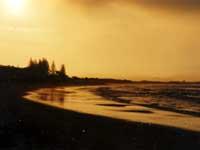
Byron Bay
Nestled on the north coast of New South Wales and serving as the main town on Cape Byron, the holiday hub of Byron Bay occupies Australia's most easterly point. It is a haven of unspoilt beaches, laid-back pursuits, some quirky locals and a spiritual atmosphere which is making it burgeon as a desirable holiday resort.
One of the greatest attractions of Byron Bay is that it's the best place on the Australian coast for land-based whale watching (between June and September). The Cape Byron walking trail offers views of dolphins playing in the waves, and humpback whales breaching as they migrate to the north. It is also undoubtedly paradise for those into adventurous outdoor activities, from skydiving to surfing. The magnificent scenery, the proximity to the rainforest, and the various nature reserves and sanctuaries make it a sought-after holiday destination for eco-tourists.
Culturally, Byron Bay prides itself in being 'alternative', boasting a number of spiritual retreats and health spas. Annual events such as the International East Coast Blues and Roots Music Festival at Easter, and the Byron Bay Writers' Festival in August, also draw the holiday crowds. Byron Bay can certainly be said to offer something for everyone, all year round.
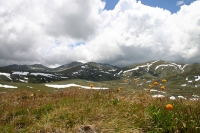
Snowy Mountains
Australia's favourite winter playground is among the peaks of the Snowy Mountains, about 315 miles (500km) south of Sydney, where there are more than 145 miles (230km) of ski-trails, graded from beginner to championship level. Ski season lasts from June to October. The ski resorts are known for their warm hospitality, spectacular scenery, and their apres-ski entertainment.
The largest resort is Perisher, which is actually four resorts united to form a Mecca for snow-seekers. Another, at the foot of Mount Crackenback, is the resort of Thredbo, which is a recreation of a European Alpine village and features Australia's longest ski run, known as the Funnelweb. Australia is generally celebrated much more for its picturesque deserts than for snow and skiing, but the Snowy Mountains provide some surprisingly good winter sports facilities.
Travellers who visit during the summer will find that the Snowy Mountains transform into an outdoor adventure playground once the snow melts. The list of activities includes climbing Australia's highest peak, tackling world-class mountain bike trails, riding horses through untouched bushland and fishing in crystal clear streams.
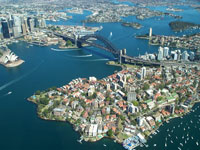
Harbour Bridge
One of Sydney's most famous landmarks, the Harbour Bridge (known locally as the 'Coat Hanger') was completed in 1932 after claiming 16 lives during its construction. The bridge spans the 1,600-foot (500m) gap from the north to the south shore, which was previously only accessible by ferry, and accommodates pedestrian walkways, two railway lines and an eight-lane road. Visitors can experience the bridge in an adventurous way by climbing to the top as part of an organised group for breath-taking views and a feeling of personal achievement. For the less daring, 200 steps lead to the Pylon Lookout for equally fantastic views at 285 feet (87m) above the water, with three levels of exhibits on the way up depicting the history and construction of the bridge. The Pylon option is better for those afraid of heights, although stomachs will still drop!
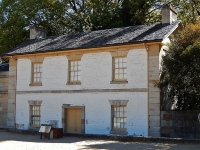
The Rocks
The best place to start exploring Australia's oldest city is at The Rocks, a restored 19th-century village at the southern end of the Sydney Harbour Bridge, which was the site of Australia's first European settlement in 1788, and is therefore considered to be the birthplace of the nation of Australia. The area features cobbled streets and squares, gas lamps, craft shops and small restaurants. Here too are several historic buildings, including one of the city's oldest, Cadman's Cottage, built in 1816, and two of Sydney's oldest pubs, the Lord Nelson and the Hero of Waterloo.
It is recommended that visitors seek information and a map from The Rocks Visitor's Centre (in George Street) in order to make the most of the neighbourhood and its many attractions, which include museums, viewing sites, markets, monuments and buildings. From The Rocks it is also possible to access the Pylon Lookout on the famous Sydney Harbour Bridge for an amazing view of the harbour and beyond.
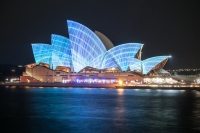
Sydney Opera House
It may not be an ancient monument, but the architecturally distinctive Sydney Opera House epitomises the city as much as the Great Pyramid in Cairo or the Acropolis in Athens. Situated on Sydney's harbour at Bennelong Point, this intriguing, white-sailed landmark is no white elephant. It is a fully functional performing arts centre in constant use.
The complex consists of a massive Concert Hall that seats more than 2,500 people and has some of the finest acoustics in the world; a smaller Opera Theatre, also used for ballet performances; a Drama Theatre, seating about 500 people; the smaller Playhouse; and the Boardwalk dance and music venue. The building, designed by Joørn Utzon, was completed in 1973 and cost over A$100 million, most of which was raised with a series of national lotteries.
There was so much controversy involved in its construction that the Danish architect returned home without ever seeing his finished product. Free performances of various types are given outside on the boardwalks around the Opera House on Sunday afternoons. A variety of tours are available.
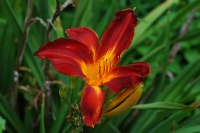
Royal Botanic Gardens
Sydney's 'green lung' is a 30-hectare botanical garden, established in 1816 and containing more than 7,500 species of plant. Australia's very first farm was on the site where the garden now flourishes, southeast of the Sydney Opera House. Paths criss-cross the gardens, leading strollers past two sets of ponds, garden sculptures and numerous horticultural areas. Visitors shouldn't miss the Sydney Tropical Centre; the rose, herb and succulent gardens; the First Farm; the Fernery; and the palm grove. The young specimen of the rare Wollemi Pine (only about 38 adult trees exist in the world) in the Pioneer Garden is a must see.
The gardens also offer some of the best views of Sydney Harbour, the Opera House and the Harbour Bridge. The path that skirts the harbour starting at the Opera House and leading around to Mrs Maquarie's Chair provides magnificent views of the harbour, particularly at sunset. The gardens have a visitor's centre, shop, restaurants and kiosks as well. Free guided walks are offered at about 10.30am every day, except public holidays. Visitors who prefer not to walk can take a scenic train tour. Inside the gardens visitors can admire Government House, formerly the residence of the New South Wales Governor, which sits atop a hillock overlooking the Opera House and Farm Cove. It is open to the public for tours.
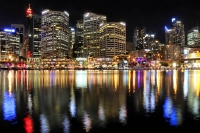
Darling Harbour
The waterside tourist precinct of Darling Harbour, close to the central business district, is crossed by a monorail and offers plenty of entertaining diversions, museums, carnival rides, restaurants and shops. Among other things, visitors will find the Imax Theatre, with Australia's largest cinema screen; the huge Star City Casino and Sydney Entertainment Centre; and the magnificent Chinese Garden, with its serpentine paths and placid pools. Established in 1988 by the local Chinese community, to celebrate their heritage and to cement the bond between Sydney and the city of Guangzhou, the Chinese Garden of Friendship is styled along Classical lines, combining the four elements of water, plants, stone and architecture to create a perfect balance. Reminiscent of the gardens of the Shang dynasty from 3,000 years ago, and a popular tourist attraction, the Garden is a wonderful place to relax and rejuvenate with the whole family, whether picnicking, or just walking the meandering paths, enjoying the pagoda-style structures, the expert landscaping, and the tranquil courtyards.
An absolute must-see is the Sydney Aquarium, one of the most popular attractions at Darling Harbour, and also one of the biggest and most impressive aquariums in the world. More than 5,000 Australian fish are displayed in their natural habitats, along with sharks, rays, platypus, seals, penguins, crocodiles and much more. Underwater walkways give visitors an intimate view of the unique aquatic environment. The Great Barrier Reef exhibit has live coral and many tropical fish, and visitors can take a glass-bottomed boat ride to see some dangerous sharks from up close.
Visitors should also look out for the National Maritime Museum and the Powerhouse Museum, where all things scientific abound and exhibits include those that will boggle the mind, and astound the senses. A ferry trip from the harbour is the best way to see the city on a budget, and passengers can look forward to undisturbed views of the city skyline.
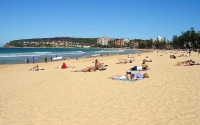
Sydney Beaches
One thing that is not in short supply in Sydney is beautiful Pacific Ocean beaches. Anywhere in the city, except perhaps in the far west suburbs, visitors will never be more than half an hour away from one. Starting from popular Palm Beach to the north, beach lovers can take their pick along the coast: there is Whale, Avalon, Bilgola, Newport, Bungan, Mona Vale, Warriewood, Narrabeen-Collaroy, Long Reef, Curl Curl, Freshwater, North Steyne, Manly and Shelly! There are several small beaches around Sydney Harbour and, moving southwards, visitors will reach the famous Bondi Beach, with its magnificent sweep of golden sand lined with an eclectic mix of ice-cream parlours, designer cafes and surf shops. The list goes on and on: a beach for everyone, all equipped with kiosks, white sand and golden bodies.
Eight miles (13km) from the city centre, Manly is perhaps the most famous of the northern beaches; it was here, in 1902, that newspaper editor William Gocher first defied the state law against public bathing and today the white sand of the south beaches and the golden sand of the north beaches are crowded with swimmers, sunbathers and surfers. Manly can be reached by ferry from Circular Quay or by foot via the Manly Scenic Walkway from Spit Bridge in the city. This walk can take three or four hours but offers some of Sydney's most breath-taking views, as well as skirting some of its most exclusive neighbourhoods. Another spectacular but much shorter walk is along the cliffs from Bondi to Bronte Beach, which takes walkers past the famous Tamarama Beach and is very popular with joggers and, at the weekend, with families.
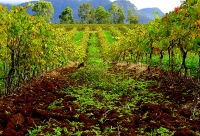
Hunter Region
The Hunter Valley region is a 60-mile (100km) drive north of Sydney. It is a region already known to the world for its high quality wine, but is also fast becoming famous as an eco-tourism destination. Besides its vineyards and eateries, there are myriad places of interest, such as Lake Macquarie, a glistening lake with magnificent beaches about 12 miles (19km) south of Newcastle; the beautiful Myall Lakes; and the attractive stretch of surfing beaches near Newcastle.
Also nearby is the Barrington Tops World Heritage Wilderness Site, which, at 5,203 feet (1,586m) above sea level, contains some of the highest untamed natural bushland in Australia. One of the most popular coastal destinations in the region is Port Stephens, renowned for its crystal clear water and golden beaches. The harbour of Port Stephens is home to about 80 dolphins and many cruise boats offer close up views of these animals. Port Stephens is also a wonderful vantage point for whale watching in season.
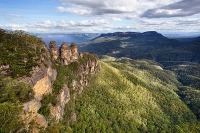
Blue Mountains
The entrance to the richly forested hills of the Blue Mountains is at Glenbrook-Lapstone, only about 50 minutes' drive from Sydney. Many coach companies offer day trips, usually from Circular Quay in Sydney. Alternatively, City Rail offers an efficient service to the Blue Mountains, or visitors can travel there direct from Sydney Airport. Once there, visitors can delight in one of the most spectacular wilderness parks in Australia. Cliff top vistas stretch across gum tree-lined valleys and craggy outcrops. It is superb walking country and adventure activities, from horse riding, caving and abseiling to tubing down mountain rivers, abound.
The region is dotted with historic towns, most built from timber and stone, connected by scenic drives. Katoomba is the most visited town in the Blue Mountains, and the amazing rock formation of the Three Sisters at Echo Point is a must-see in the area. A great drawcard is the Blue Mountains 'Yulefest'. Visitors flock to the mountaintops in July and August to experience a mid-year Christmas and to revel in the occasional snowfall. Many of the region's guesthouses, hotels, motels, resorts and restaurants put on all the trappings of a traditional Christmas, complete with turkey, Christmas pudding and a great deal of fun.
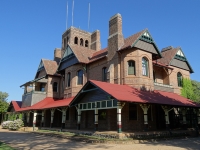
New England
Also known as 'Big Sky Country', the New England region of New South Wales is a place of spacious beauty where it is possible to enjoy the great outdoors in the cool summers as well as cosy hospitality in the crisp winters. The centre of New England is Australia's country-music capital, Tamworth. The city has hosted the Australian Country Music Festival every January since 1973. Tamworth's population doubles to more than 60,000 when aficionados from across the land gather for the multi-day event, which culminates in the Golden Guitar Awards.
Besides the music, Tamworth's other claim to fame is that it was the first town in the southern hemisphere to be lit by electricity. This historical fact has been enshrined in the Powerhouse Museum in town. Beyond Tamworth, the Big Sky Country includes tens of thousands of hectares of national park and provides fun outdoor activities for visitors, including horse riding, abseiling, fishing, fossicking, canoeing and bushwalking. Each national park offers distinct flora and fauna and a multitude of natural attractions.
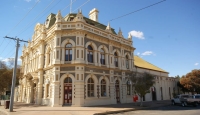
Broken Hill
The historic town of Broken Hill lies in western New South Wales, in the area known as the 'Living Outback'. Here red dust roads lead off to national parks, opal fields, remote settlements and the Darling River. In Broken Hill art and mining live side by side as uncomfortable companions. Artists have come here to find their inspiration, at a spot where incredible wealth has been produced by exploitation of one of the world's greatest mineral deposits. Broken Hill is known as 'Silver City', being the site of the world's richest deposit of silver, lead and zinc.
Visitors can visit a simulated mine or the real thing, donning lighted helmets to enter the subterranean world of the miners. This town is also a Mecca for artists and film-makers and has more than 20 art galleries. The famous Outback Royal Flying Doctor Service and School of the Air are also worth a visit. Visitors can tour the aircraft hangar or the radio room, which handles calls to and from remote towns and stations, covering 80 percent of Australia and treating about 160,000 patients a year.
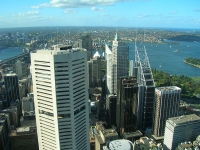
Sydney Tower
Sydney Tower, or the AMP Centrepoint Tower, is the tallest free-standing structure in the city, and one of the tallest in the country. Situated above the Centrepoint office building and shopping centre, the tower is one of the most popular tourist attractions in Sydney for its 360-degree views and Tower Skywalk platform. The observation deck is 820 feet (250m) above the city, with an enclosed viewing platform offering information on the points of interest. The Sydney Tower Skywalk platform sits above the observation deck at 853 feet (260m) above the ground, twice the height of the harbour bridge, and harnessed to the glass-floored platform, daredevils can hang out over the city far below.
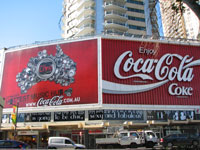
Kings Cross
Once home to music halls and grand theatres, Kings Cross was transformed after World War II with the arrival of hundreds of troops visiting from the nearby naval base, and today still carries the reputation as the city's red-light district. Although the nightclubs, strip clubs, bars, restaurants and adult shops are still there, the atmosphere is slowly changing and levels of prostitution and drug-use have declined in recent years. The introduction of trendy cafes and the redevelopment of apartment buildings are attracting a wider crowd of people. The Cross is most sleazy at night when the bright lights come on, but during the day is an interesting mix of characters and is becoming increasingly artistic in its leanings.
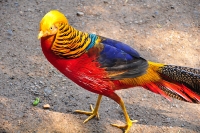
Featherdale Wildlife Park
Families who visit the Featherdale Wildlife Park will be able to interact with and observe unique Australian animals such as koalas, wallabies and emus up close and personal. Kids can have their photograph taken with one of these fuzzy animals and petting the koalas is also allowed, a rare thing in New South Wales. These popular favourites are members of one of the country's largest collections of native animals and bird life, and there are many other animals to meet. At the park there is also a cafe, a souvenir shop, and some picnic areas with barbeque facilities. Featherdale promises fun for animal lovers of all ages!
Eating Out
A multi-cultural and cosmopolitan city, Sydney has a wide variety of restaurants and cuisines showcasing diverse influences from around the world, but particularly from Asia. Along with modern Australian ('Mod Oz') cuisine, which combines fresh ingredients with a creative blend of European and Asian styles, restaurants serve almost any type of fare imaginable, from Tibetan to African, from Russian to American. Some areas or streets are dedicated to one type of food, while other areas in the city offer a variety of styles. The range also varies from award-winning, fine dining restaurants - situated mainly around the harbour or attached to five-star hotels - to international fast food takeaways such as McDonalds or Pizza Hut. Fresh seafood is in abundance, and steak is a staple that can be found in a selection of steakhouse chain restaurants scattered around the city.
The main dining areas in the centre of Sydney are The Rocks, Circular Quay, Darling Harbour and Chinatown. Prices vary according to location, with harbour facing establishments generally charging more for their views. Some restaurants are BYO, which means they are unlicensed, but diners can bring their own wine (sometimes a small corkage fee will be charged). All restaurants are non-smoking.
Shopping
Shopaholics will not be disappointed with Sydney, a cosmopolitan city that offers international as well as local name brands, world-class shopping centres, streets that reveal a host of fascinating speciality shops, and discounted market stalls that offer anything from clothes to arts and crafts and edibles.
Most of the large department stores are within the city centre and within a few blocks of each other. For exclusive shopping, the QVB, or Queen Victoria Building, is an architectural masterpiece housing a large variety of designer label and speciality shops, while in similar vein the nearby Strand Arcade houses some of Australia's top designer labels, as well as boutiques, jewellery shops and beauty salons. Downtown Duty Free in the basement is a great place to pick up some bargains. Other centres include Sydney's oldest department store, David Jones; the Harbourside development at Darling Harbour; MLC Centre; Picadilly; and Westfield Sydney shopping centre. Visitors can explore the streets of The Rocks, which hide myriad speciality shops.
Sydney's biggest market is Paddy's, open from Thursday to Sunday, which offers discounted mainstream items, while the Glebe (Saturday) and Bondi (Sunday) markets are traditional alternative markets with a good selection of clothing, arts and crafts, and second-hand goods. The Rocks has weekend stalls trading mainly in good quality crafts, collectibles, and art. For something totally different the daily Sydney Fish Market is a fishy spectacle as well as a great place to feast on fresh seafood. A wider variety of food can be bought at Coles or Woolworths supermarkets.
Nightlife
Sydney's nightlife is all go, with everything from pubs and jazz bars to rock venues and nightclubs. The best party areas include Darling Harbour, Oxford Street and The Rocks.
Oxford Street is the epicentre of the LGBT nightlife scene in the city, though there are many straight bars and clubs as well. Kings Cross is the reputed Red Light District of Sydney, an area which has seen some improvement over the last few years, attracting an increasingly diverse and arty array of visitors, but it remains a gritty nightlife centre, as one would expect for an area once dominated by sailors and brothels. The Rocks and Kings Street Wharf offer more upmarket entertainment options. Sydney is also renowned for its performing arts, the most notable venue being the iconic Sydney opera House.
The legal drinking age in Australia is 18. There are some lock-out and last drinks laws in effect in the Sydney CBD Entertainment Precinct, with no drinks served after 3am at hotels and registered nightclubs, but some smaller venues are exempt from these rules.
Getting Around
Sydney has a good network of buses, trains and ferries that make getting around the city and the surrounds easy. The bus network is the most extensive and cheapest mode of public transport, but can be slow due to traffic jams. There are also several hop-on hop-off Explorer buses for tourists that take in the major sights and surrounding beaches. The underground city centre train loop is the fastest way to get around, but many of the tourist areas, including Darling Harbour, Bondi Beach and Manly, can only be reached by further ferry or bus connections. The most pleasurable way to get around is by ferry - the main terminal is at Circular Quay. There is also a 10-minute monorail loop from the city centre to Darling Harbour and back, and a Metro Light Rail 'tram' system between Central Station and Wentworth Park in Pyrmont. In addition, metered taxis are plentiful and fairly economical. Hiring a car for short visits is not recommended due to heavy congestion (in peak hours) and limited parking in the city centre.
Sydney Climate and Weather
The summer season (December to February) is the most popular time to visit Sydney, with temperatures generally exceeding 77F (25C). November and March are favoured by visitors wanting sunshine without the searing heat. Winters (June to August) are mild, with temperatures averaging between 63F (17C) and 48F (9C). Winter nights are likely to be chilly. Rainfall is evenly distributed throughout the year but it is slightly wetter between March and June.
Australia travel info
Electricity
Electrical current is 230 volts, 50Hz. Three-pin flat blade plugs are used but are different to those in most other countries, so an adapter is normally required.
Language
English is the official language of Australia.
Money
The unit of currency is the Australian dollar (AUD), which is divided into 100 cents. Credit cards are widely accepted and ATMs are freely available throughout the country. Banks and bureaux de change exchange most foreign currencies. Banking hours are generally 9.30am to 4pm, Monday to Thursday, and 9.30am to 5pm on Friday, but some banks offer extended hours and some are open on Saturday mornings.
Tipping
Most service providers in Sydney don't expect a tip, so travellers shouldn't feel pressured into giving one. A tip of 10 percent is standard in restaurants, however, and passengers usually round up to the nearest dollar or more in taxis.
Health
A yellow fever vaccination certificate is required by travellers over one year of age arriving within six days of having stayed overnight or longer in an infected country. No other special immunisations or medications are required for most trips to Australia; however, insect repellents are strongly advised because of the risk of mosquito-borne illnesses. Another health risk is sunburn, and visitors are advised to take precautions. Medical services are excellent but can be expensive, so travellers should ensure that they have adequate insurance. Australia has a reciprocal health agreement with the United Kingdom providing for free hospital emergency medical treatment; proof of UK residence is required.
Safety
The crime rate in Australia is low; however, travellers should be aware that tourists could be targeted by petty criminals. Visitors should be vigilant about personal possessions and travel documents, particularly in popular tourist destinations such as along the Gold Coast. Tropical cyclones normally occur between November and April in some parts of Australia, particularly in Western Australia, Queensland and the Northern Territory. There is a serious risk of bush fires in summer (November to March), especially in Victoria, Tasmania, New South Wales and ACT. Also during the summer months, the shallow coastal waters of northern Australia and Queensland become infested with marine stingers, commonly known as box jellyfish, whose sting is highly dangerous and can be deadly. Visitors should pay attention to signs on beaches and follow the instructions of local lifeguards to avoid injury.
Local customs
Generally an informal attitude, in dress and behaviour, prevails in most social and business situations. Sport, particularly rugby and cricket, is almost a religion in Australia.
Doing business
Those doing business in Australia are sure to find that the friendly yet professional corporate atmosphere of the country will provide them with an exciting opportunity to develop their careers. The business culture of Australia is a bit of a hybrid breed, incorporating the trappings of British formality and conservatism, the egalitarian ethos of Scandinavian countries, and the dynamic, innovative approach to business that is generally thought of as American in origin - rounded out, of course, with typical Australian warmth and humour. The approach to management in Australia is consultative, pragmatic, and strictly non-hierarchical. Those in positions of relative power are accorded respect by virtue of their personal qualities, not simply because they happen to be the boss.
Business etiquette in Australia further reflects this egalitarian ethos. Business people should use titles initially, though they will almost certainly be told to dispense with them and refer to their colleagues by their first names. They should maintain eye contact when speaking to their associates, as this is regarded as a sign of forthrightness and trustworthiness, qualities that Australian business people tend to favour over showiness, self-aggrandisement or empty promises. Business meetings in Australia should be scheduled about a week in advance, and then confirmed a few days before they are due to take place.
Colleagues should be punctual, as lateness can be seen as a symptom of flakiness or indifference. Business meetings in Australia do not generally proceed from a set agenda. Rather, they are viewed as open forums, in which ideas are to be debated and discussed. In fact, over-preparing for a meeting can make participants seem pushy, as though they wish to bully others into adopting their opinions on the issue at hand. The dress code for business in Australia remains surprisingly traditional: dark suits and ties are the norm for men; for women, business suits, worn either with pants or a skirt. As a general rule, business people should avoid loud jewellery and accessories, as to Australian eyes they might make them seem arrogant. The official language of business in Australia is English, and business hours are generally from 8.30am (or 9am) to 5pm (or 5.30pm), Monday to Friday.
Duty free
Travellers to Australia over 18 years do not have to pay customs duty on 2.25 litres of alcohol; and 25 cigarettes or 25g of cigars or tobacco products. All tobacco products in travellers' baggage are included in this category, regardless of where they were purchased. Gifts are included in the A$900 duty-free allowance. Fresh produce and animal or plant products are prohibited.
Communications
The international dialling code for Australia is +61. Hotels, cafes and restaurants offering free WiFi are widely available; purchasing a local prepaid SIM card can be a cheaper option than paying international roaming costs, which can be quite high.
Passport & Visa
A valid passport and a visa or ETA is required for travel to Australia. An ETA is an electronically issued and verified visa, not visible in a passport. ETAs are issued to passengers travelling for touristic or business purposes. Tourist ETAs are usually valid for three months. ETAs are obtainable online at: www.eta.immi.gov.au or through most travel agents. It is highly recommended that passports are valid six months after departure from a holiday destination.
Entry requirements
US nationals must have a valid passport on arrival. A pre-obtained Electronic Travel Authority (ETA) is required for stays of up to three months.
UK nationals must have a passport valid for intended period of stay. A pre-arranged Electronic Travel Authority (ETA) is required for stays of up to three months.
Canadian nationals require a passport valid for intended period of stay. A pre-arranged Electronic Travel Authority (ETA) is required for stays of up to three months.
South African nationals must have a passport valid for at least six months after their date of departure. A visa is required.
Irish nationals must have a passport that is valid on arrival. A pre-arranged Electronic Travel Authority (ETA) is required for stays up to three months.
New Zealanders require a valid passport on entry to Australia. A Special Category Visa (SCV) is issued on arrival after completing a passenger card.
Useful contacts
Australian Tourist Commission, Sydney: +61 (0)2 9360 1111 or www.australia.com
Emergencies: 000 (112 on cellphones)Embassies / consulates in other countries
Embassy of Australia, Washington DC, United States: +1 202 797 3000.
Australian High Commission, London, United Kingdom: +44 (0)20 7379 4334.
Australian High Commission, Ottawa, Canada: +1 613 236 0841.
Australian High Commission, Pretoria, South Africa: +27 (0)12 423 6000.
Australian Embassy, Dublin, Ireland: +353 (0)1 664 5300.
Australian High Commission, Wellington, New Zealand: +64 (0)4 473 6411.
Embassies / consulates in Australia
Embassy of the United States, Canberra: +61 (0)2 6214 5600.
British High Commission, Canberra: +61 (0)2 6270 6666.
Canadian High Commission, Canberra: +61 (0)2 6270 4000.
South African High Commission, Canberra: +61 (0)2 6272 7300.
Embassy of Ireland, Canberra: +61 (0)2 6214 0000.
New Zealand High Commission, Canberra: +61 (0)2 6270 4211.


